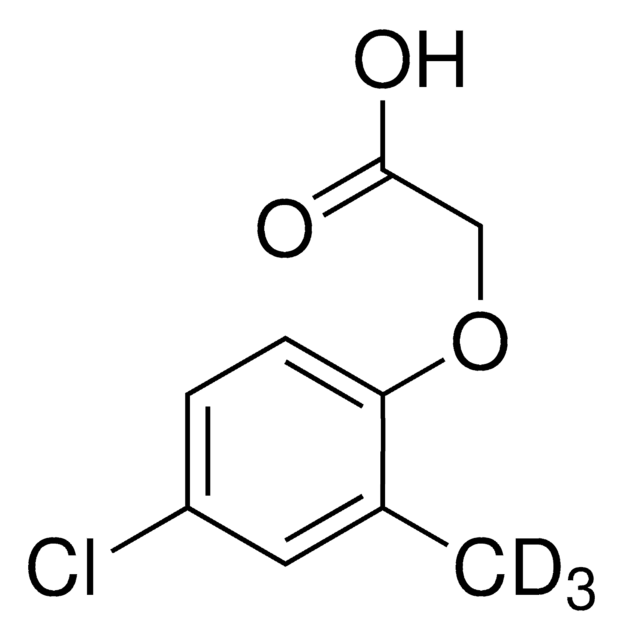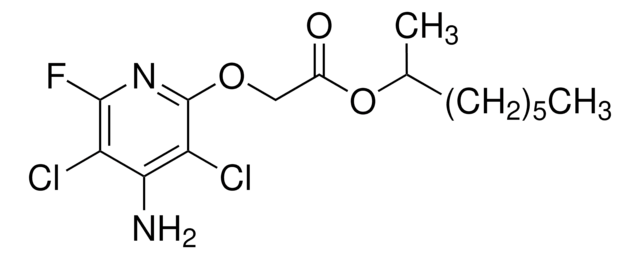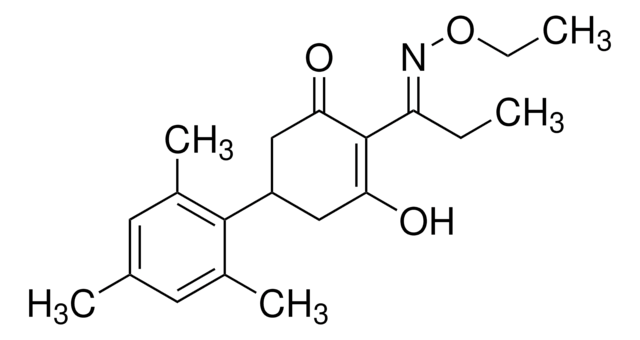36773
Mecoprop-P
PESTANAL®, analytical standard
Synonym(s):
(R)-2-(4-Chloro-2-methylphenoxy)propionic acid
About This Item
Recommended Products
grade
analytical standard
product line
PESTANAL®
shelf life
limited shelf life, expiry date on the label
application(s)
agriculture
environmental
format
neat
SMILES string
C[C@@H](Oc1ccc(Cl)cc1C)C(O)=O
InChI
1S/C10H11ClO3/c1-6-5-8(11)3-4-9(6)14-7(2)10(12)13/h3-5,7H,1-2H3,(H,12,13)/t7-/m1/s1
InChI key
WNTGYJSOUMFZEP-SSDOTTSWSA-N
Looking for similar products? Visit Product Comparison Guide
General description
Mecoprop-P is approved for its use in the European Union. Maximum residue levels (MRLs) have been set according to Reg (EC) No 149/2008 for mecoprop-P as a sum of mecoprop-P and mecoprop expressed as mecoprop for various products of plant origin from 0.05 to 0.1 mg/kg.
Mecoprop-p was included in Annex I to Directive 91/414/EEC on 01 June 2004. It is listed as one of the active substances in Regulation (EU) No 686/2012 according to the renewal procedure of the approval of active substances submitted under Article 14 of Regulation (EC) No 1107/2009.
Application
- To investigate the relationships between soil depth, the biodegradation of mecoprop-p, and the copy number and diversity of the tfdA gene group
- Study of adsorption and desorption behavior of two phenoxyalkanoic acid herbicides in a Haplic Cambisol with tillage and grassland management using a batch equilibrium method
- To investigate the persistence of S-metalachlor, bentazon, isoproturon, and mecaprop-P in heavy metal contaminated soil before and after EDTA-based remediation
- To assess the effects of mecoprop, mecoprop-p, and their biodegradation compound 2-methyl-4-chlorophenol on two larval stages of Crassostrea gigas
- To study adsorption-desorption Nicosulfuron and the ionic pesticide Mecoprop-P on a calcined Mg-Al hydrotalcite (HT-500) in the presence and absence of various anions
Legal Information
Signal Word
Danger
Hazard Statements
Precautionary Statements
Hazard Classifications
Acute Tox. 4 Oral - Aquatic Acute 1 - Aquatic Chronic 1 - Eye Dam. 1
Storage Class Code
11 - Combustible Solids
WGK
WGK 2
Flash Point(F)
Not applicable
Flash Point(C)
Not applicable
Personal Protective Equipment
Certificates of Analysis (COA)
Search for Certificates of Analysis (COA) by entering the products Lot/Batch Number. Lot and Batch Numbers can be found on a product’s label following the words ‘Lot’ or ‘Batch’.
Already Own This Product?
Find documentation for the products that you have recently purchased in the Document Library.
Our team of scientists has experience in all areas of research including Life Science, Material Science, Chemical Synthesis, Chromatography, Analytical and many others.
Contact Technical Service











